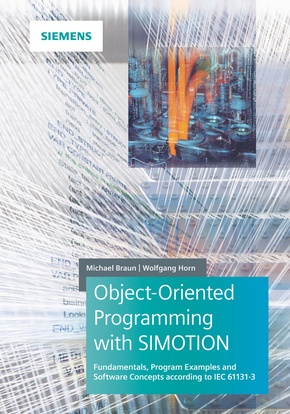Object-Oriented Programming with SIMOTION - Fundamentals, Program Examples and Software Concepts according to IEC 61131-3
| Verlag | Wiley-VCH |
| Auflage | 2017 |
| Seiten | 297 |
| Format | 17,7 x 2,2 x 25,3 cm |
| Gewicht | 962 g |
| Artikeltyp | Englisches Buch |
| ISBN-10 | 3895784567 |
| EAN | 9783895784569 |
| Bestell-Nr | 89578456A |
Die Tendenz im Maschinenbau hin zu immer flexibleren Lösungen führt auch zu Veränderungen bei den Steuerungen. Mit der Zunahme mechatronischer Systeme und modularer Funktionseinheiten ergeben sich hohe Anforderungen an die Software und deren Programmierung. In der Automatisierungstechnik wird daher in den nächsten Jahren der gleiche Wandel stattfinden, der in der PC-Welt bereits erfolgt ist, hin zu besserem und klarerem Softwaredesign, zu einfacher Änderbarkeit und Modularität. Dafür brauchen wir Objektorientierte Programmierung.
Das Buch richtet sich an alle, die sich mit dieser zukunftsweisenden Entwicklung in der Automatisierungstechnik vertraut machen möchten. Egal ob man angehender Ingenieur, Techniker oder erfahrener Automatisierungstechniker ist: Es hilft, die Objektorientierte Programmierung zu verstehen und anzuwenden.
SIMOTION stellt ab Softwarestand 4.5 die Möglichkeit der Nutzung von OOP entsprechend IEC 61131-3 ED3, der Norm für speicherprogrammierbare Steuerung en, zur Verfügung. Das Buch unterstützt den Umgang mit dieser Denk- und Programmierweise und bietet Programmierbeispiele zu verschiedenen objektorientierten Techniken und den dabei wirkenden Mechanismen. Die Beispiele sind aufeinander aufbauend gestaltet, so dass am Ende ein komplettes, verwendbares Maschinenmodul entsteht.
In mechanical engineering the trend towards increasingly flexible solutions is leading to changes in control systems. The growth of mechatronic systems and modular functional units is placing high demands on software and its design. In the coming years, automation technology will experience the same transition that has already taken place in the PC world: a transition to more advanced and reproducible software design, simpler modification, and increasing modularity. This can only be achieved through object-oriented programming.
This book is aimed at those who want to familiarize themselves with this development in automation technology. Whether mechanical engineers, technicians, or experienced automation engineers, it can help readers to understand and use object-oriented programming.
From version 4.5, SIMOTION provides the option to use OOP in accordance with IEC 61131-3 ED3, the standard for programmable logic controllers. The book supports this way of thinking a nd programming and offers examples of various object-oriented techniques and their mechanisms. The examples are designed as a step-by-step process that produces a finished, ready-to-use machine module.
Contents: Developments in the field of control engineering - General principles of object-oriented programming - Function blocks, methods, classes, interfaces - Modular software concepts - Object-oriented design, reusable and easy-to-maintain software, organizational and legal aspects, software tests - I/O references, namespaces, general references - Classes in SIMOTION, instantiation of classes and function blocks, compatible and efficient software - Introduction to SIMOTION and SIMOTION SCOUT.

